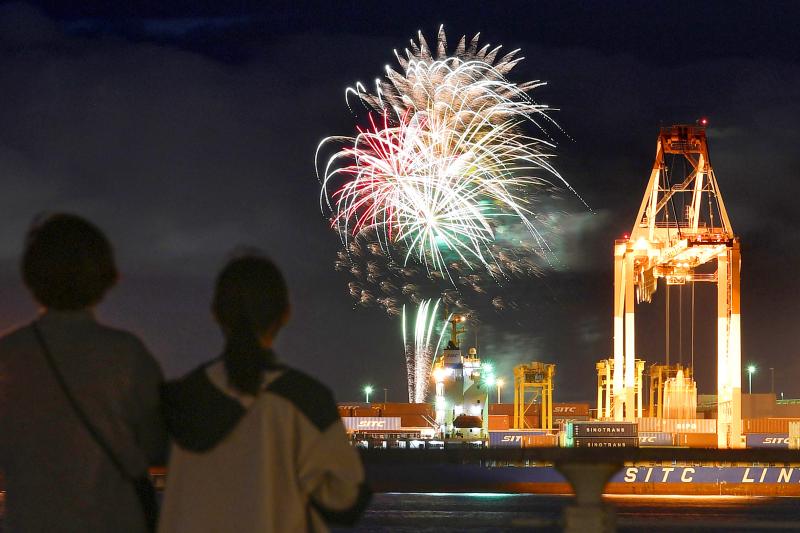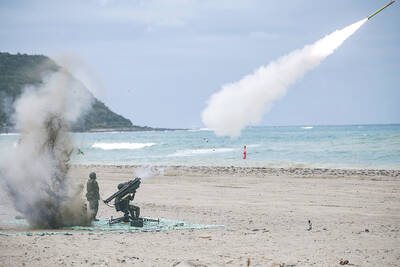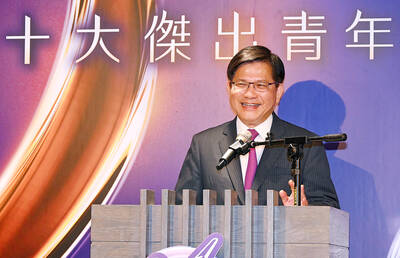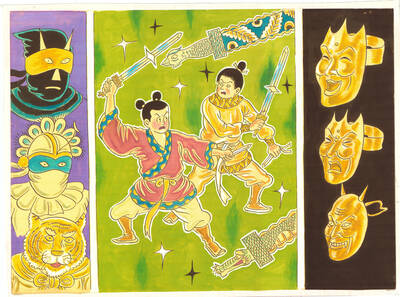Dozens of fireworks displays erupted simultaneously across Japan on Monday to cheer up the public, urge the gods to end the coronavirus pandemic and provide practice for struggling pyrotechnic artisans.
More than 160 manufacturers launched their displays at precisely 8pm at secret locations across the country for a five-minute display called “Cheer up Hanabi” (fireworks).
In an era of social distancing, the synchronized shows were designed to be long enough for people to rush to balconies or doorsteps to see them but too short for people to race to the launch sites.

Photo: AP
With traditional summer festivals canceled due to the coronavirus, fireworks artisans said they wanted to bring light to the skies during these dark times.
“Historically fireworks in Japan have been launched to pray for the eradication of plagues and to console the spirits of the deceased,” Tokyo craftsman Kouhei Ogatsu, 38, said.
“In the business we have been discussing what we can do in this society that has been changed so much by the coronavirus,” and decided to hold shows nationwide to cheer up the public, he said.
The pandemic has been particularly harsh for fireworks producers who spend all year making and testing their crafts and now are unable to sell them because summer festivals have been called off, said Ogatsu, whose family has run a fireworks business in Tokyo since 1864.
Artisans need to keep making fireworks in order to maintain their skills. But they can only keep a certain amount of gunpowder by law, forcing them to search for ways to use their stock but avoid encouraging crowds.
‘FAR, FAR AWAY’
Even before the coronavirus spelled the end for many summer festivals, several fireworks displays had been rescheduled or canceled due to the Tokyo 2020 Olympics. Now that the Games have been postponed until next summer, displays could be pushed back yet another year to free up resources such as security guards for the sporting event.
“For fireworks manufacturers, the exit from the pandemic is far, far away,” Ogatsu said.
Hours before the show began, Ogatsu’s staff carefully placed their fireworks in metal launchers at the Ookunitama Jinja shinto shrine in Fuchu city, a Tokyo suburb, as a gentle rain fell.
The shrine held an elaborate prayer ceremony to bless the team and to tell the gods their wish for the virus to end.
The crew also inserted written messages praying for the end of the pandemic into the fireworks.
At the shrine, Ogatsu’s team fired 15 volleys into the sky, which burst up to 70m wide in a cascade of colorful sparks.
His company launched a total of nearly 100 fireworks from four locations across eastern Japan. Ogatsu also included blue sparks to show his appreciation for medical workers.
“Of course I don’t think the coronavirus will disappear with our fireworks. But we wanted to do this and hope something good will come out of it,” he said after the event.
“The very purpose of fireworks is to bring out crowds and be seen by people. But we must not create crowds.”

In late October of 1873 the government of Japan decided against sending a military expedition to Korea to force that nation to open trade relations. Across the government supporters of the expedition resigned immediately. The spectacle of revolt by disaffected samurai began to loom over Japanese politics. In January of 1874 disaffected samurai attacked a senior minister in Tokyo. A month later, a group of pro-Korea expedition and anti-foreign elements from Saga prefecture in Kyushu revolted, driven in part by high food prices stemming from poor harvests. Their leader, according to Edward Drea’s classic Japan’s Imperial Army, was a samurai

The following three paragraphs are just some of what the local Chinese-language press is reporting on breathlessly and following every twist and turn with the eagerness of a soap opera fan. For many English-language readers, it probably comes across as incomprehensibly opaque, so bear with me briefly dear reader: To the surprise of many, former pop singer and Democratic Progressive Party (DPP) ex-lawmaker Yu Tien (余天) of the Taiwan Normal Country Promotion Association (TNCPA) at the last minute dropped out of the running for committee chair of the DPP’s New Taipei City chapter, paving the way for DPP legislator Su

It’s hard to know where to begin with Mark Tovell’s Taiwan: Roads Above the Clouds. Having published a travelogue myself, as well as having contributed to several guidebooks, at first glance Tovell’s book appears to inhabit a middle ground — the kind of hard-to-sell nowheresville publishers detest. Leaf through the pages and you’ll find them suffuse with the purple prose best associated with travel literature: “When the sun is low on a warm, clear morning, and with the heat already rising, we stand at the riverside bike path leading south from Sanxia’s old cobble streets.” Hardly the stuff of your

April 22 to April 28 The true identity of the mastermind behind the Demon Gang (魔鬼黨) was undoubtedly on the minds of countless schoolchildren in late 1958. In the days leading up to the big reveal, more than 10,000 guesses were sent to Ta Hwa Publishing Co (大華文化社) for a chance to win prizes. The smash success of the comic series Great Battle Against the Demon Gang (大戰魔鬼黨) came as a surprise to author Yeh Hung-chia (葉宏甲), who had long given up on his dream after being jailed for 10 months in 1947 over political cartoons. Protagonist